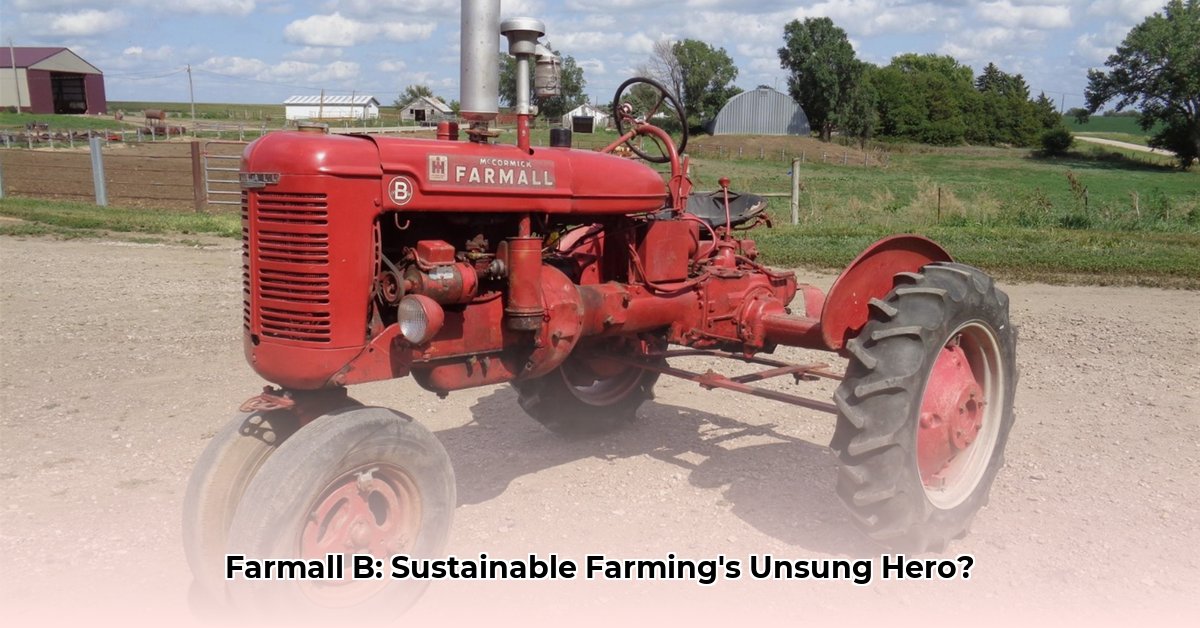
The Farmall B. The name itself evokes images of hardworking farmers and a simpler era. But this wasn't just any tractor; it was a revolutionary machine, a symbol of resilience during challenging times, and a pivotal force in shaping modern agriculture. For more Farmall models, check out this useful resource. Let's journey back to the late 1930s and early 1940s to understand its enduring legacy.
Farming in the Shadow of the Great Depression and World War II
Picture the American heartland in the late 1930s. The Great Depression's grip lingered, heavily impacting farmers. Many struggled for survival, making efficient farming methods not just desirable, but essential. The looming threat of World War II intensified this urgency. Food production became critical for national security, demanding even greater efficiency. Farmers needed a helping hand, and the Farmall B answered the call. While not the most powerful tractor, its affordability and versatility made it a lifeline for countless small and medium-sized farms – a true "people's tractor." Didn't this widespread adoption speak volumes about its impact on the agricultural landscape?
Getting to Know the Farmall B: Technical Details and Design
The Farmall B wasn't flashy; its brilliance lay in its ingenuity. Its 1.9-liter four-cylinder engine could run on gasoline or kerosene – a remarkably practical feature, especially considering the fuel constraints of the time. Kerosene, often more economical, made it a financially viable option for resource-strapped farmers. Although its horsepower was modest by today's standards, it represented a significant upgrade from earlier methods—a huge leap forward for manual labor reduction. The dual-fuel capability offered unprecedented flexibility, adapting to farmers' needs. This adaptability reflected the resilience of the farmers themselves.
Here's a concise overview of its key features (though further research is needed to complete some specifications):
| Feature | Specification | Notes |
|---|---|---|
| Engine | 1.9L Four-Cylinder | Reliable and relatively easy to maintain. |
| Fuel Options | Gasoline, Kerosene | Kerosene offered a more affordable alternative. |
| Power Output | (Further research needed) | Sufficient for many tasks of the era. |
| Fuel Tank Capacity | 37.9 Liters | Provided a good working range before refueling. |
| Transmission | (Further research needed) | Likely a manual transmission, typical for the time. |
| Weight | (Further research needed) | Relatively lightweight, minimizing soil compaction. |
A Revolution in Farming Practices: Efficiency and Sustainability
The Farmall B didn't merely bring mechanization to the farm; it revolutionized farming practices. Farmers could cultivate more land with less labor, boosting efficiency and, consequently, yields. This efficiency, some argue, also contributed to more sustainable practices as farmers could produce the same amount of food with smaller acreages. However, it's crucial to acknowledge the Farmall B’s power limitations; it wasn’t suitable for all tasks or large-scale operations, excelling primarily in row-crop agriculture due to its narrower tread width.
Production, Sales, and Market Dominance
The Farmall B’s popularity transcended mere preference; it was a production phenomenon. Hundreds of thousands were manufactured between 1939 and 1947, reflecting both the tractor’s success and the immense demand for efficient farming solutions during those critical years. The war effort played a vital role; ensuring national food security became paramount, making investment in the agricultural sector a national priority. While precise sales figures require further investigation, the Farmall B undoubtedly held a substantial market share, becoming a dominant force in its class.
The Farmall B's Lasting Impact: A Legacy of Innovation
Though a vintage machine now, the Farmall B retains a significant place in agricultural history. Its influence extended beyond the fields it worked; it symbolized ingenuity and the will to overcome adversity, shaping the American agricultural landscape and contributing to a more efficient food production system. It marked a crucial shift from horse-drawn implements to mechanized farming, paving the way for future innovations. Its simplicity, though seemingly basic by today's standards, was its strength—affordability, adaptability, and essential efficiency during a pivotal period. The Farmall B serves as a powerful reminder of the potential impact of seemingly simple innovations when they meet a critical societal need.
Three Pivotal Points:
- The Farmall B's affordability and versatility made it accessible to small and medium-sized farms during the Great Depression and World War II.
- Its dual-fuel capability (gasoline and kerosene) provided flexibility during times of fuel scarcity.
- The tractor significantly increased farming efficiency, contributing to higher yields and potentially more sustainable practices.